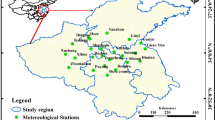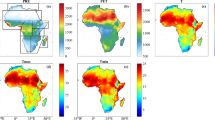Abstract
Entropy is a useful tool to measure the uncertainty of precipitation. However, the necessary length of the precipitation time series is not clear because of the highly spatial-temporal variability of precipitation and the quite different mechanisms of entropy indices. Thus, this study aims at exploring the relationship between necessary length of daily precipitation time series and the typical entropy indices, including information entropy and sample entropy, denoted as IE and SE respectively. Firstly, the probability distribution of the entropy calculated from data with the same length is identified using the K-S test. Based on the confidential interval of 95%, the threshold value and the necessary length are obtained. On the basis of the results calculated by 675 65-year-length daily precipitation time series in China, the spatial distributions of the minimum length and their influencing factors are uncovered. The main findings are manifested by the following aspects. Generally, the entropy calculated from data with the same length follows a normal distribution, from which the threshold value is obtained: coefficient of variance, CV, equaling to 0.025 on the basis of the 95% confidential interval. The average necessary length is 35 years for SE and 24 years for IE, with the range of 8–58 years and 5–60 years respectively. Spatially, the necessary length is mainly affected by the climatic conditions: smaller values observed in southern humid areas while the larger value in arid areas. The necessary length for SE, NLSE, is larger than the data length for IE, NLIE, in the southern areas. However, the NLSE is smaller than NLIE in part of extreme arid areas. The reason is mainly the different mechanism of the two entropy measures: a lower frequency of precipitation events in arid areas require a longer period to capture almost all of the rainfall intensity to make the probability distribution stable. These results would not only provide some useful references to determine the necessary data length when explore the temporal variability of SE with the climate change, but also provide a deeper insight into understanding the different entropy measures for precipitation time series.










Similar content being viewed by others
References
Berne A, Delrieu G, Creutin JD, Obled C (2004) Temporal and spatial resolution of rainfall measurements required for urbanhydrology. J Hydrol 299:166–179
Brunsell NA (2010) A multiscale information theory approach to assess spatial-temporal variability of daily precipitation. J Hydrol 385:165–172
Buishand TA (1977) Stochastic modelling of daily rainfall sequences (Doctoral dissertation, Veenman)
Burgueño A, Martinez MD, Serra C, Lana X (2010) Statistical distributions of daily rainfall regime in Europe for the period 1951–2000. Theor Appl Climatol 102(1–2):213–226
Chou CM (2012) Applying multiscale entropy to the complexity analysis of rainfall-runoff relationships. Entropy 14(5):945–957
Chou CM (2014) Complexity analysis of rainfall and runoff time series based on sample entropy in different temporal scales. Stoch Env Res Risk A 28(6):1401–1408
Conrad K (2004) Probability distributions and maximum entropy. Entropy 6(452):10
Costa MD, Goldberger AL, Peng CK (2002) Multiscale entropy analysis of complex physiologic time series. Phys Rev Lett 89(6):068102
Costa MD, Goldberger AL, Peng CK (2005) Multiscale entropy analysis of biological signals. Phys Rev Lett 71:021906
Duan J, Sikka AK, Grant GE (1995) A comparison of stochastic models for generating daily precipitation at the. HJ Andrews Experimental Forest
Eckmann, J. P., & Ruelle, D. (1985) Ergodic theory of chaos and strange attractors. In The theory of chaotic attractors. Springer, New York (pp. 273–312)
Fischer T, Su B, Luo Y, Scholten T (2012) Probability distribution of precipitation extremes for weather index–based insurance in the Zhujiang River basin, South China. J Hydrometeorol 13:1023–1037
Geng S, de Vries FWP, Supit I (1986) A simple method for generating daily rainfall data. Agric For Meteorol 36(4):363–376
Grassberger P, Procaccia I (1983) Estimation of the Kolmogorov entropy from a chaotic signal. Phys Rev A 28(4):2591–2593
Hasan MM, Dunn PK (2011) Entropy consistency in rainfall distribution and potential water resource availability in Australia. Hydrol Process 25:2613–2622
Huang F, Xia Z, Zhang N, Zhang Y, Li J (2011) Flow-complexity analysis of the upper reaches of the Yangtze River, China. J Hydrol Eng 16(11):914–919
Jiang GJ, Fan SZ, Abbod MF et al (2015) Sample entropy analysis of EEG signals via artificial neural networks to model patients' consciousness level based on anesthesiologists experience. Biomed Res Int 2015:1–8
Kawachi T, Maruyama T, Singh VP (2001) Rainfall entropy for delineation of water resources zones in Japan. J Hydrol 246(1–4):36–44
Kolmogorov AN (1958) A new metric invariant of transient dynamical systems and automorphisms in Lebesgue spaces. Doklady Akademii Nauk. Russian Academy of Sciences 119(5):861–864
Li Z, Zhang YK (2008) Multi-scale entropy analysis of Mississippi River flow. Stoch Env Res Risk A 22(4):507–512
Li S, Zhou Q, Wu S et al (2006) Measurement of climate complexity using sample entropy. International Journal of Climatology: A Journal of the Royal Meteorological Society 26:2131–2139
Liu B, Chen X, Lian Y, Wu L (2013) Entropy-based assessment and zoning of rainfall distribution. J Hydrol 490:32–40
Liu M, Xu X, Sun AY, Wang K, Liu W, Zhang X (2014) Is southwestern China experiencing more frequent precipitation extremes? Environ Res Lett 9(6):064002
Liu R, Liu S, Cicerone R et al (2015) Trends of extreme precipitation in eastern China and their possible causes. Adv Atmos Sci 32(8):1027–1037
Marsaglia G, Marsaglia J (2004) Evaluating the Anderson-darling distribution. J Stat Softw 9(2):1–5
Maruyama T, Kawachi T, Singh VP (2005) Entropy-based assessment and clustering of potential water resources availability. J Hydrol 309:104–113
Mishra AK, Özgera M, Singh VP (2009) An entropy-based investigation into the variability of precipitation. J Hydrol 370:139–154
Mooley DA, Crutcher HL (1968) An application of the gamma distribution function to Indian rainfall (Vol. 5). US Environmental Science Services Administration, Environmental Data Service
Pincus SM (1991) Approximate entropy as a measure of system complexity. Proc Natl Acad Sci 88(6):2297–2301
Richman JS, Moorman JR (2000) Physiological time-series analysis using approximate entropy and sample entropy. Am J Phys Heart Circ Phys 278(6):2039–2049
Shannon CE (1948) A mathematical theory of communication. Bell Syst Tech J 27:379–423
Sinai YG (1959) On the notion of entropy of a dynamical system, vol 124. Doklady of Russian Academy of Sciences, pp 768–771
Singh VP (2010) Entropy theory for hydrologic modeling. J Beijing Norm Univ Nat Sci 46:229–240
Tsallis C, Plastino AR, Zheng WM (1997) Power-law sensitivity of initial conditons-new entropic represent on. Chaos, Solitions Fractals 8(6):885–891
Wilks DS (1995) Statistical methods in the atmospheric sciences: an introduction. Academic Press, San Diego
Zhang R (2001) Relations of water vapor transport from Indian monsoon with that over East Asia and the summer rainfall in China. Adv Atmos Sci 18:1005–1017
Zhao C, Ding Y, Ye B, Yao S, Zhao Q, Wang Z, Wang Y (2011) An analyses of long-term precipitation variability based on entropy over Xinjiang, northwestern China. Hydrol Earth Syst Sci Discuss 8(2):2975–2999
Zhou X, Lei W (2018) Complex patterns of precipitation and extreme events during 1951-2011 in Sichuan Basin, southwestern China. J Mt Sci 15(2):340–356
Zhou Y, Zhang Q, Li K, Chen X (2012) Hydrological effects of water reservoirs on hydrological processes in the East River (China) basin: complexity evaluations based on the multi-scale entropy analysis. Hydrol Process 26(21):3253–3262
Zhou, X., Liang, X., Lin, J., Xu, W. (2015) Identify precipitation pattern using multiscale sample entropy. American Geophysical Union fall meeting, NG31A-1829
Zhou X, Zhang R, Lei W (2018) Comparisons on probability distributions of extreme precipitation events identified by different methods. Journal of natural disasters 27(5):1–11 (in Chinese with English abstract)
Acknowledgements
The research was supported by Science and Technology Funding of Guizhou Province (grant numbers LH [2017]7290), Science and Technology Funding of Water Resources Department of Guizhou Province (grant numbers KT201707), National Natural Science Foundation of China (grant number 41701558) and The first class subject foundation of Civil Engineering of Guizhou Province (QYNYL[2017]0013),.
Author contributions statement
Chunmin Zhang, the first author, was responsible for the calculating and the writing this manuscript; Xiangyang Zhou as the corresponding author proposed the idea of this study, and was responsible for collecting the data and revising the manuscript. Wenjuan Lei, the third author, searched the background of the hydrological effect of oasis and helped to revise this manuscript. All authors have read and approved the final manuscript.
Author information
Authors and Affiliations
Corresponding author
Ethics declarations
Conflict of interest
The authors declare no conflict of interest.
Additional information
Publisher’s note
Springer Nature remains neutral with regard to jurisdictional claims in published maps and institutional affiliations.
Rights and permissions
About this article
Cite this article
Zhang, C., Zhou, X. & Lei, W. Necessary length of daily precipitation time series for different entropy measures. Earth Sci Inform 12, 475–487 (2019). https://doi.org/10.1007/s12145-019-00392-1
Received:
Accepted:
Published:
Issue Date:
DOI: https://doi.org/10.1007/s12145-019-00392-1




